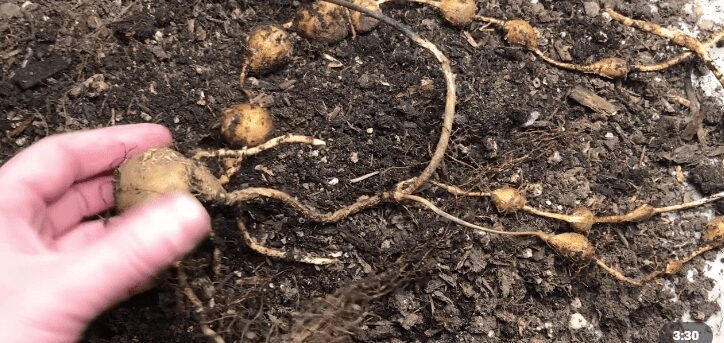Tasty and Ready to Harvest

Groundnuts, Apios americana, also known as Indian potatoes, wild beans, and hopniss, have a long history in the east. They were an important part of the diets of both Native Americans and European settlers.
Apios americana tubers, like potatoes, kept well once excavated and hence offered a vital cold-weather staple.
Groundnuts are an outstanding cuisine. They not only overwinter well, but they are also high in protein, about three times that of a potato.
They can also be peeled, boiled, fried, buttered, and seasoned like potatoes.
A word of caution: eating them uncooked is not advised due to the danger of soil bacterium contamination. In addition, a limited proportion of persons are allergic to groundnuts.
What Are The Groundnut Benefits?
Groundnuts can be eaten raw, but they are most commonly cooked or roasted before being added to soups and stews.
They have a mild taste and are used equally to potatoes, but are more nutritious. They have three times the protein of potatoes.
They can also be preserved for an extended amount of time in a cold, dry place, similar to potatoes.
Cultivating groundnuts as a cultivar has failed twice in Europe, the first time during the Great Potato Famine.
What’s the reason?
Tubers need two to three years to mature, whereas potatoes require only one growing season. As a result, they were vital food sources for the new colonies.
When the pilgrims of Plymouth ran out of corn, they subsisted on groundnuts. The tubers are perennial and may be gathered at any time of year, which was a gift to the early colonists.
How To Grow Groundnuts
Tubers or young plants are accessible from a few nurseries, or of course, you can scoop them up yourself if they grow in your woods.
Put on rough gloves and long pants and shirt sleeves to shield from the poison ivy, no doubt growing with the groundnuts.
Plant the groundnuts in spring, ideally in a raised bed in light, well-draining soil. Maintain the plants with support since groundnuts have an upright Vining nature.
Have the garden free of weeds to hinder pests but be gentle around the root ball of the tubers.
Seedlings require at least two growing years and a minimal photoperiod of 14 hours to stimulate blossoms.
Harvesting
While you may pick these tubers at any time of year, after a frost or two has sweetened them but before the earth becomes too hard to dig.
Pack your field guide before heading out to look for groundnuts, as there are other Viney plants growing in the same area, such as the hog peanut (which also contains tasty tubers) and poison ivy (which surely you do not want to try digging up).
Look for damp forests or low, thicket-like vegetation along a body of water. Along rivers, I’ve always found groundnuts.
Because the blooms are normally gone by this time of year, check for the vines, which can grow to be more than 10 feet long and will wrap and twist around the stems of any nearby plants.
The alternating leaves are four to eight inches long, with seven leaflets that are about two inches long.
After washing, the skin of the tubers can be peeled off with a potato peeler or knife. Groundnuts can then be sliced up and fried in oil or bacon grease, boiled and buttered, or added to soups or stews.
Groundnuts have a light nutty flavor that is fairly tasty. While I won’t be replacing mashed potatoes with mashed groundnuts this Thanksgiving, I do recommend giving these wild tubers a try.
Medicinal Benefits Of Groundnuts
Apios americana (A. Americana) Medik is a Leguminosae family perennial vine that is commonly consumed by Native Americans.
Apios tubers contain isoflavonoids, such as genistein, barpisoflavone A, 2′-hydroxygenistein, 5-methylgenistein, and 2′-hydroxy genistein-7-O-gentibioside;
these have been shown to exhibit antioxidant, soluble epoxide hydrolase inhibitory and tyrosinase inhibitory activities, which are beneficial for the treatment of hypertension and diabetes
Previous research found that lupinalbin A extracted from A. Americana has anti-inflammatory properties in LPS-induced RAW264.7 cells.
Lupinalbin A has also been demonstrated to have a-glucosidase inhibiting action.
Nonetheless, the mechanism underlying lupinalbin A’s inhibition of -glucosidase and the molecular interactions of lupinalbin A with DPP4 remain unknown.
Resource of Medicinal reference:
Biomedical Reports; Athens Vol. 14, Iss. 4, (2021). DOI:10.3892/br.2021.1415






















